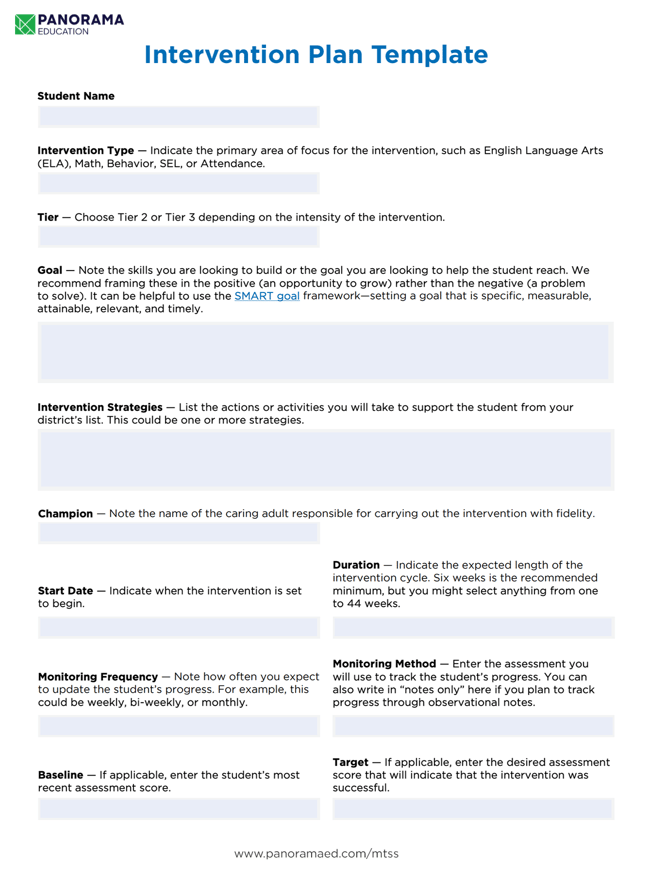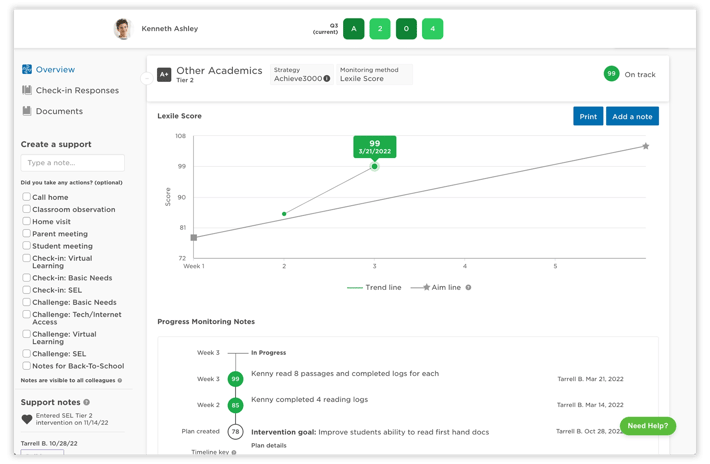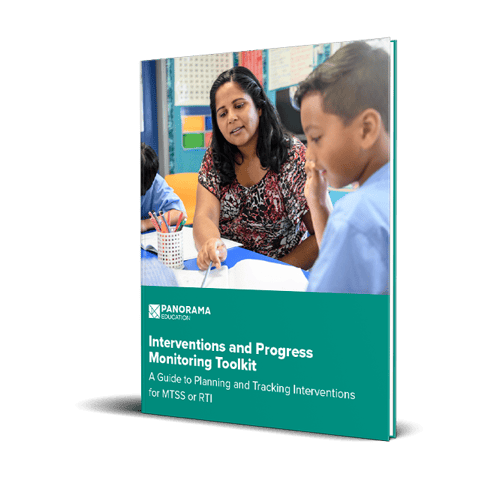Implementing a multi-tiered system of supports (MTSS) without an intervention planning process is like trying to teach a class without a lesson plan. If you don't know where you're going (or have a plan for getting there), you won't be able to effectively support students.
Intervention plans are typically used as part of student support team processes for MTSS, RTI (response to intervention), or PBIS (positive behavioral interventions and supports). Once a caring adult determines that a student needs targeted support, the next step is to create an intervention plan.
In this post, we'll cover how to write an intervention plan and share a helpful template for getting started.
Table of Contents
How to Write an Intervention Plan
- Identify the Student(s)
- Choose an Intervention Type and Tier
- Create a Goal for the Student's Intervention Program
- Select an Intervention Strategy
- Assign an Adult Champion
- Set a Timeline
- Establish a Method for Progress Monitoring
What Is an Intervention Plan?
An intervention plan is a blueprint for helping a student build specific skills or reach a goal. In other words, it's an action plan.
In general, intervention plans include a goal, intervention strategy, timeline, and progress monitoring method.
What Makes a Good Intervention Plan?
Before you get started building an intervention plan, make sure you have the necessary data! Look at the student's progress across multiple dimensions—such as academics, behavior, and attendance. This can help you make more informed decisions about what the student needs.
Here's a scenario to demonstrate this point:
|
Allie struggles with reading and acts out in reading class. You know this by looking at her academic and behavior data. However, data shows that Allie is also reporting a low sense of self-efficacy—which is how much students believe they can succeed in achieving academic outcomes. Together, this data paints the story that Allie is acting out in reading class in order to avoid having to read. Instead of prescribing a standard Check In, Check Out (CICO) behavior intervention for Allie, you may instead decide on delivering an intervention called “Breaks Are Better”—a modified CICO intervention that helps students take breaks rather than engage in unwanted avoidance behavior. |
In addition to being data informed, good intervention plans are measurable and time-bound. You'll want a clear way to measure if the student is progressing, and a plan for how long you'll deliver the intervention.
The goal is to reach a decision point at the end of an intervention plan. Maybe the student has met their goal, and you can close out their intervention plan. Maybe the student is progressing, but the intervention should continue. Or, maybe the current intervention plan isn't working and it's time to rethink the strategies in place.
How to Write an Intervention Plan
Once you've determined that a student can benefit from targeted support, it's time to create an intervention plan. This plan will be your blueprint for helping the student build specific skills or reach a goal. You can download the intervention plan template below to follow step-by-step instructions to writing an intervention plan.

Download the above worksheet as an editable PDF and Excel document.
Pro tip for Panorama Users: Panorama Student Success simplifies the process of creating intervention plans. Click on “Create Plan” on a student’s profile page to build a plan for improving the student’s academic performance, behavior, or attendance. You can even generate a secure, temporary link for families to view students’ intervention plans and their progress.
1. Identify the student(s)
Which student will you be supporting? First, record the student's name at the top of the plan. You might also include additional information such as grade level, gender, or other demographic attributes or identifiers used by your school.
(Keep in mind that you can also create an intervention plan for a small group of students that you're working with. The steps to create a group plan are the same.)
2. Choose an intervention type and tier
What is the area of focus for the intervention? What subject (or domain) can the student benefit from extra support in? Examples could be English language arts (ELA), math, behavior, life skills, or attendance.
Next, specify Tier 2 or Tier 3 depending on the intensity of the intervention. Here is a refresher on the MTSS pyramid:
.png?width=447&height=251&name=MTSS%20Pyramid%20(1).png)
-
Tier 3 includes more intensive interventions for students who needs are not assed at Tiers 1 or 2.
-
Tier 2 consists of individualized interventions for students in need of additional support.
-
Tier 1 is the foundation and includes universal supports for all students.
3. Create a goal for the student's intervention program
This is when you'll identify specific skills to be developed, or the goal you are looking to help the student achieve.
Remember to frame these in the positive (an opportunity to grow) rather than the negative (a problem to solve).
It can be helpful to use the SMART goal framework—setting a goal that is specific, measurable, attainable, relevant, and timely.
For example, to build a student's self-efficacy in math, you might set the following goal: “Charles will be able to complete 80% of his do-now activities at the beginning of each math lesson with the support of manipulatives.”
4. Select an intervention strategy
With the intervention goal in mind, identify a strategy or activity that could help this student reach the goal. Sample intervention strategies include 2x10 relationship building, a behavior management plan such as behavior-specific praise, graphic organizers, a lunch bunch, WOOP goal-setting, and math time drills.
Your school district may already have an evidence-based intervention menu to pick from. For example, if your district partners with Panorama, you have access to our Playbook, with over 900 evidence and research-based interventions. In fact, the Panorama platform recommends interventions from Playbook whenever you create an intervention plan.
If you don't have an existing intervention menu, here are a few resources to get help you get started building your own library:
- How to Build a Tiered Intervention Menu
- 5 PBIS Interventions for Tier 1 to Use in Your District Today
- 42 MTSS Intervention Strategies to Bring Back to Your Support Team
- 18 Research-Based Interventions for Your MTSS
- 20 Evidence-Based Interventions for High School Students
5. Assign an adult champion
Who will carry out the intervention plan with fidelity? A teacher? Interventionist? School counselor?
Clear ownership is key. Whether it's one adult or a team, make sure to document who will be responsible for delivering the intervention(s), logging notes, and monitoring student progress.
6. Set a timeline
Next, set a clear prescription for how often and how long an intervention will take place. Record a start date (when the intervention is set to begin) and a duration (the expected length of the intervention cycle). We recommend five to six weeks at a minimum so the intervention has a chance to take hold.
7. Establish a method for progress monitoring
You're almost done! The last step in building a great intervention plan is deciding on a data collection strategy.
Once the intervention plan is underway, it's important to collect and record qualitative and/or quantitative data at regular intervals. Many goals are best tracked quantitatively, such as reading level growth or computational fluency. Other goals (behavioral goals, for example) might be best tracked qualitatively—like making note of how a student is interacting with peers in class. (Learn more about the fundamentals of progress monitoring for MTSS/RTI.)
Don't forget to include the following information on your intervention plan:
- Monitoring Frequency: How often you'll update the student’s progress over the course of the intervention cycle. For example, this could be weekly, bi-weekly, or monthly.
- Monitoring Method: The assessment you'll use to track the student’s progress. Indicate a baseline (the student’s most recent assessment score) and target (desired assessment score). Alternatively, you might plan to track progress through observational notes.
Example of a reading intervention plan in Panorama Student Success (mock data pictured)
If you use Panorama for MTSS: When creating an intervention plan, you'll see recommended interventions based on the goals of the plan. Then, log qualitative and quantitative notes to monitor a student's progress over time. The notes are saved to the student profile so other educators in your school can stay up-to-date on the student's progress.
|
Frequently Asked Questions: 1. How do I determine if a student needs targeted support through an intervention plan? To identify students in need of targeted support, educators can analyze academic, behavioral, well-being, and attendance data. Look for patterns or discrepancies indicating areas where students may require additional assistance. Collaborating with colleagues and involving students in the process can also provide valuable insights. 2. What role do parents or guardians play in the intervention planning process? Parents or guardians are essential partners in the intervention planning process. Educators should communicate regularly with families to share progress updates, solicit feedback, and discuss strategies for supporting the student at home. Collaborative efforts between school and home environments enhance the effectiveness of interventions and promote student success. 3. How do I select the most appropriate intervention strategy for a student? Choosing the right intervention strategy involves considering the student's specific needs, strengths, and challenges. Educators should assess the student's response to previous interventions, gather input from colleagues and support staff, and consult research-based resources. Tailoring interventions to align with the student's goals and preferences increases the likelihood of success. 4. How can educators ensure fidelity and consistency in implementing intervention plans? Consistent implementation of intervention plans requires clear communication, ongoing monitoring, and shared responsibility among all stakeholders. Educators should establish protocols for documenting progress, provide training and support to staff involved in intervention delivery, and maintain open lines of communication with students, families, and support team members. Regular review meetings and data-driven decision-making processes can help ensure fidelity to the intervention plan. |
Put This Into Practice
Now that you have the building blocks for writing an effective intervention plan, there's only one thing left to do: put it into action. If you're an MTSS leader or coordinator for your district, we hope that you'll share this process (and template!) with your building-level student support teams. If you are an educator working with a specific student, we hope that this process helps you stay organized as you deliver supports.
Access intervention planning resources in our free Interventions and Progress Monitoring Toolkit


![How to Write an Intervention Plan [+ Template]](https://www.panoramaed.com/hubfs/intervention%20planning-1.jpg)




